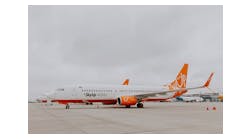The spring 2016 air travel season is on track to be the busiest ever, with passenger volume exceeding 2015’s peak by 3 percent. According to Airlines for America, 140 million passengers were expected to fly America’s airlines during March and April. That equates to 2.3 million people a day traversing through the nation’s airports – 2.3 million people who need to get to their gates, find the way to the restroom, grab a bite to eat, buy gifts and souvenirs for the family, and kill time between connections. And with airlines warning passengers to arrive at the airport at least two hours ahead of their flights, it’s a truly captive audience.
The increase in passenger traffic combined with longer wait times is putting pressure on airports to up their game in terms of passenger experience. Airports are investing heavily in upgrading technology and experience, with a goal of trying to make average airline passengers feel like they are sitting in their living rooms instead of an airport lobby.
Ten years ago, when a passenger walked into an airport, there would typically be a video wall made of 10 TVs. That was new and fancy technology back then. But now, that’s considered “old school.” Airports have since migrated to LED displays, which are seamless and flash beautiful colors, but our collective brains are still adjusting to their vividness, so they don’t have the same impact as they did when first introduced. They are starting to blend in with the rest of the scenery at airports and passengers just don’t notice them as much anymore. Airports are now looking to use LED display technology to make a statement, provide useful information and provide an additional stream of revenue in the form of advertising.
Providing Dynamic Wayfinding
Typically, displays used for wayfinding in airports have been static, providing basic information like Gate A is to the left and Gate B is to the right. These displays are very boring and to quote a past client, “make you feel like you are in an airport.” But, LED displays for wayfinding can be so much more. They can be dynamic, alternating between wayfinding information and tailor-made content. Current digital display technology gives airports the ability in real-time to send out alerts, change flight and gate information, and offer passengers content that can be designed to create a relaxing atmosphere. In airports in Japan, the use of digital displays for wayfinding is even more sophisticated. If an airplane from America lands in Japan, the digital display at the gate changes to English. If the plane is arriving from France, the language on the display changes to French – especially useful for non-English speaking cultures that typically don’t see their native languages written on signage.
In Case of Emergency
Advancing LED technology is helping to make the work lives of people who run airports easier and more efficient and makes the airports themselves safer. Digital display technology has the capacity to change messaging quickly, amplifying an airport’s ability to get important messages out to the flying public. LED technology also minimizes the risk of making communications mistakes during a crisis. In a panic situation, it’s very easy for messaging to become garbled when multiple people are involved in spreading the word, much like the children’s game of telephone. If multiple security guards are given the responsibility of telling people what to do, it’s likely that these multiple, changed versions of the message will be dispersed. With digital display technology, the same emergency messaging can be put on every display in the airport with the touch of a few buttons – one consistent message delivered to every concourse and every gate.
Adding More Revenue Through Advertising
Because airports are investing more heavily in infrastructure to be competitive in offering a better level of passenger experience, they need to figure out ways to generate more and more revenue. Converting static displays, otherwise known as posters, to digital displays allows airports to utilize that same space to sell to eight different advertisers instead of one advertiser. Airports can multiply the amount of revenue per location exponentially. Most airports don’t exist in a big enough market to sell to that many advertisers, so they can enlist the help of national players to sell out the space. The benefit of this type of arrangement for airports comes in the form of cost sharing. By bringing in partners, airports can share on the cost of the infrastructure.
Displays as Attractions
Airports are now looking to use LED display technology in a way that makes the displays themselves architectural features, so the display becomes an event. For example, the new display in Toronto’s international airport is in the shape of a flower. Half of a flower petal has flight information on it; the other half has advertising. But the advertising becomes almost subliminal because the passengers are concentrating on the flight information. The flower display gives the airport the ability to run content, but passengers won’t necessarily know it’s an LED display. The whole point is to make people think the display is cool and interesting – to stop passengers in their tracks. Subliminally, the passengers aren’t thinking about the ads. Display technology can also be imbedded into an actual wall, so the device is flush, making the LED display look like it’s part of the rest of the wall. Then suddenly, the content of the display changes, catching people by surprise. The excitement of the changing content helps create the aura felt by a passenger that he or she is not in an airport.
The good news for airports is that the price point for LED displays is coming down, making them more affordable. Through implementing digital displays, airports can attract additional advertising dollars and provide passengers with a unique experience. LED displays let passengers find their way through airports and get access to information quicker and more efficiently. Meanwhile, passengers are treated to impactful imagery and content, designed to delight and entertain, resulting in higher levels of customer satisfaction.
Almir DeCarvahlo is the vice president of strategic accounts at NanoLumens.
LEARN MORE






